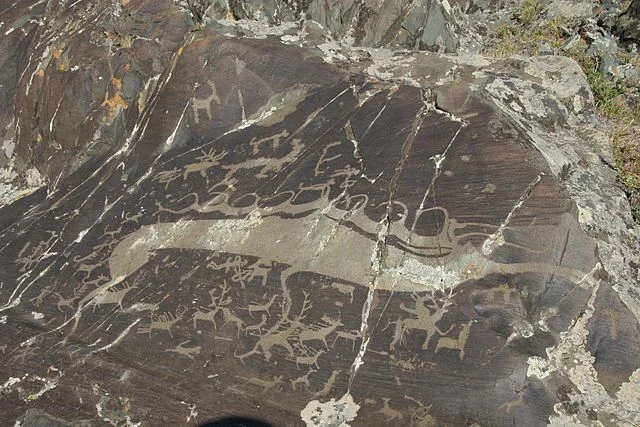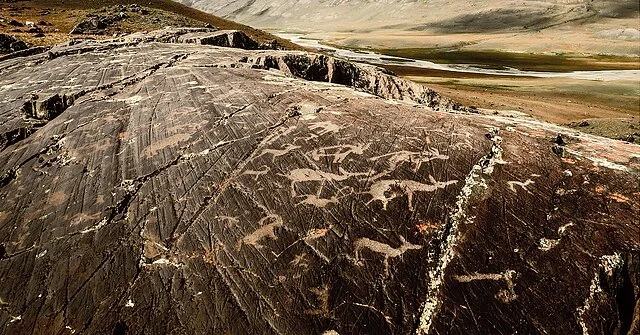The Tsagaan Salaa rock paintings, located in Mongolia’s Altai Mountains, represent one of the most significant petroglyph sites in Central Asia. These paintings are a vital source of information about the early inhabitants of this region, offering insight into their lives, beliefs, and environment.
Get your dose of History via Email
Location and Discovery

The Tsagaan Salaa rock paintings are found in the upper reaches of the Tsagaan River, in the Altai Tavan Bogd National Park. Archaeologists discovered the site in the 1990s. Since then, it has been studied extensively by researchers from Mongolia and other countries. The site’s location in a remote mountain region has helped preserve the art, which dates from around 11,000 BC to 1000 AD.
Artistic Themes and Styles
The petroglyphs at Tsagaan Salaa cover a wide range of artistic themes. Most depict animals such as deer, ibex, and horses. The hunting scenes, which show human figures interacting with animals, reveal early hunting techniques and the importance of animals in the culture. Warriors, chariots, and human figures are also common, showing the evolution of social and military organization over time.
The style of the paintings changed over thousands of years. The earlier figures are simple and stick-like, while later ones become more detailed and naturalistic. These changes help archaeologists understand the cultural and technological developments of the people who created them.
Cultural Significance
The Tsagaan Salaa paintings are crucial for understanding the cultural development of early human societies in Mongolia and Central Asia. They reveal the role of hunting, warfare, and ritual practices in these societies. The presence of chariots, for example, suggests contact with other ancient cultures that used wheeled vehicles, including those in Central Asia and the Near East.
Moreover, the petroglyphs indicate that the region served as a crossroads for different cultural groups. The diversity of the figures and symbols supports the idea of widespread interaction among different populations. This makes the Tsagaan Salaa site an important cultural and historical landmark.
Conservation Efforts
Due to their remote location, the Tsagaan Salaa rock paintings have remained relatively well-preserved. However, increased tourism and environmental changes pose risks to the site. Conservation efforts are ongoing to protect the paintings and ensure their preservation for future generations. The Mongolian government, with the support of international organizations, is working to balance tourism development with the protection of these ancient artworks.
Conclusion
The Tsagaan Salaa rock paintings provide a unique window into the past, offering insight into the lives of early Mongolian societies. Their detailed depictions of animals, hunting, and social organization make them an invaluable source for understanding the cultural evolution of the region. As researchers continue to study these ancient artworks, they reveal more about the history and development of human civilization in Central Asia. Preservation of these paintings is essential for future generations to explore and learn from this significant cultural heritage.
Source:

